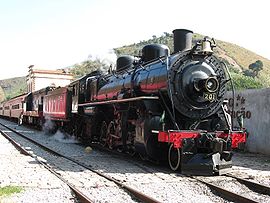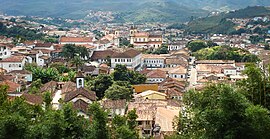Mariana (Brazil)
| Mariana | ||
|---|---|---|
|
Coordinates: 20 ° 23 ′ S , 43 ° 30 ′ W Mariana on the map of Minas Gerais
|
||
| Basic data | ||
| Country | Brazil | |
| State | Minas Gerais | |
| City foundation | July 16, 1696 | |
| Residents | 53,989 (IBGE 2008) | |
| City insignia | ||
| Detailed data | ||
| surface | 1193.293 | |
| Population density | 44.4 inhabitants / km 2 | |
| Time zone | UTC −3 | |
| Website | ||
| Look at Mariana | ||
| View to the Igreja São Pedro dos Clérigos | ||
Mariana is a city in the Brazilian state of Minas Gerais and one of the oldest cities in Brazil.
location
Mariana is located on the so-called " Gold Circle ", in the central tourist area of Minas Gerais in the vicinity of the well-known World Heritage Site Ouro Preto . Just like this, Mariana's appearance is strongly influenced by the Brazilian baroque .
Unlike Ouro Preto , the city with around 50,000 inhabitants is more tranquil and less touristy.
history
Mariana was founded in 1696 (1703 according to other sources) as the oldest city and first capital of Minas Gerais on the banks of the Ribeirão do Carmo River. In 1712 it was elevated to the status of the village of Vila Real de Nossa Senhora , and in 1745 to the city of Cidade Mariana . She was named Mariana after Dona Maria Ana D'Austria, as Maria Anna of Austria , wife of the Portuguese King Dom João V , is known in Brazil.
geography

Mariana is 110 km from Belo Horizonte , the capital of Minas Gerais .
- Important neighborhoods:
The center of Mariana consists of several densely populated neighborhoods: Rosário, São Gonçalo, São Pedro, Santana, Centro comercial, Barro Preto and São Sebastião (also known as Colina). There are also more remote areas such as Jardim dos Inconfidentes, Vila Maquiné, Cruzeiro do Sul, São Cristóvão, Cabanas and Santa Rita de Cassia. The districts of Passem de Mariana (5 km outside the city, by the Mina da Passem mine ), Monsenhor Horta, Cachoeira do Brumado, Furquim, Padre Viegas also belong to Mariana.
economy
Mariana is of great economic importance to the region. The strongest industries are tourism and mining. The city, which, like Ouro Preto, profited from the gold rush in Brazil, is one of the cities of the "iron square", in which large amounts of iron ore are traditionally mined.
The breach of a dam at an iron ore mine in the Mariana district on November 5, 2015 led to an environmental disaster . Toxic sludge got into the Rio Doce and into the Atlantic Ocean .
Attractions

The main attractions of the city are:
- Praça de Minas Gerais , home to three of the city's outstanding architectural monuments: the old town hall and prison, the Church of St. Francis of Assisi ( Igreja São Francisco de Assis ) and the Church of Our Lady of Carmel ( Igreja Nossa Senhora do Carmo ).
- The Catedral da Sé , the most important and one of the largest churches in the city. It is located on the Praça da Sé , the main square of the city and itself also a tourist attraction.
- In the cathedral there is an organ by Arp Schnitger , restored in 2002 , which was manufactured in Germany in 1701 and initially installed in Lisbon by Schnitger's employee Heinrich Hulenkampf. In 1752 she was transferred to Mariana. 14 of the 18 registers are still completely or partially preserved. Currently (November 2008) there are organ concerts twice a week (Friday and Sunday).
- Archbishop's Museum of Sacred Art - one of the richest archives of sacred art in Brazil.
- Mariana Music Museum in the Centro cultural Dom Frei Manoel da Cruz (the old bishop's palace). The only museum of its kind on the American continent, its archive contains documents and scores from the past three centuries, as well as a permanent exhibition in which visitors not only see but also feel the music.
- Building of the Curia - Archdiocese of Mariana.
- The Direita , in which the oldest houses in the city are
- The church of São Francisco de Assis, by Aleijadinho was created
- The Church of Our Lady of the Rosary ( Igreja de Nossa Senhora do Rosário ).
- The Church of St. Anton ( Igreja de Santo Antônio ), which is the oldest church in the city.
- The Church of St. Peter of the Clergy ( Igreja de São Pedro dos Clérigos ) with its extraordinary architecture.
- The Mina da Passem mine , which was of great importance to the city's economy during the gold rush in the late 17th and early 18th centuries.
The steam locomotive Maria Fumaça ("Maria Rauch") drives its train through the valley between Mariana and Ouro Preto . Although the train takes almost an hour to cover the 12 km, it is very popular with tourists from all over the world. While traveling on the train, which only resumed operations in April 2006, the passenger gets to see an impressive landscape. The old Mariana train station has been completely renovated so that it is now also a tourist attraction. The city library is also housed in it.
There are some waterfalls around the city such as B. the Cachoeira do Brumado or the Cachoeira da Serrinha .
sons and daughters of the town
- João Baptista Vieira Godinho (1742–1811), Portuguese military and colonial administrator
- Aloísio Hilário de Pinho (* 1934), emeritus Roman Catholic Bishop of Jataí
Web links
Individual evidence
- ↑ Anne Herrberg: A lifeline that has become muddy brown . Environmental disaster in Brazil. In: tagesschau. ARD, November 27, 2015, accessed on December 2, 2015 .





